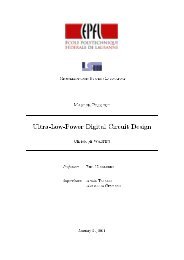Compressive Sensing system for recording of ECoG signals in-vivo
Compressive Sensing system for recording of ECoG signals in-vivo
Compressive Sensing system for recording of ECoG signals in-vivo
You also want an ePaper? Increase the reach of your titles
YUMPU automatically turns print PDFs into web optimized ePapers that Google loves.
AbstractThe project “<strong>Compressive</strong> <strong>Sens<strong>in</strong>g</strong> <strong>system</strong> <strong>for</strong> <strong>record<strong>in</strong>g</strong> <strong>of</strong> <strong>ECoG</strong> <strong>signals</strong> <strong>in</strong>-<strong>vivo</strong>” has beencarried out as challeng<strong>in</strong>g collaboration between the Microelectronic System Laboratoy (LSM)<strong>of</strong> the École Polytechnique Fédérale de Lausanne (EPFL, Switzerland) and the researchnanotechnology centre IMEC, (Leuven, Belgium). In this way, the context <strong>of</strong> the thesis has beenboth, academic and <strong>in</strong>dustrially oriented. Regard<strong>in</strong>g the latest rank<strong>in</strong>g from Leiden Universityhas just been released at the end <strong>of</strong> 2011, and EPFL comes <strong>in</strong> at number twelve <strong>in</strong> the worldrank<strong>in</strong>g and tops the table as the first non-American <strong>in</strong>stitution. EPFL and ETHZ, at 12th and18th place respectively, rank as the top two non-American <strong>in</strong>stitutions. Consider<strong>in</strong>g IMEC, it hasbuilt a research campus is headquartered <strong>in</strong> Leuven, but additional R&D teams <strong>in</strong> TheNetherlands, Ch<strong>in</strong>a, Taiwan, and India, and <strong>of</strong>fices <strong>in</strong> Japan and the USA Belgium. It extendsover 24,400m² <strong>of</strong> <strong>of</strong>fice space, laboratories, tra<strong>in</strong><strong>in</strong>g facilities, and technical support rooms,<strong>in</strong>clud<strong>in</strong>g a 300nm and a 200mm cleanroom.Dur<strong>in</strong>g the period which has taken place <strong>in</strong> EPFL, the motivation <strong>of</strong> the present project hasbeen, first <strong>of</strong> all, a deep study <strong>of</strong> the state <strong>of</strong> art <strong>of</strong> the new reveal<strong>in</strong>g methodology <strong>of</strong> signalcompression called <strong>Compressive</strong> <strong>Sens<strong>in</strong>g</strong>. This phase has <strong>in</strong>cluded mathematical basis toaccomplish compression, applicability scope and a wide range <strong>of</strong> different k<strong>in</strong>d algorithms <strong>for</strong>the signal recovery solution. In this way, models <strong>in</strong> Matlab and Simul<strong>in</strong>k have been implemented<strong>in</strong> order to apply an efficient compression and a reliable reconstruction.In the last years, <strong>Compressive</strong> <strong>Sens<strong>in</strong>g</strong> has emerged as a revolutionary compression technique<strong>for</strong> sparse biological <strong>signals</strong>, which are becom<strong>in</strong>g a high-dense source <strong>of</strong> <strong>in</strong><strong>for</strong>mation <strong>in</strong>multielectrodes arrays-based bio-<strong>system</strong>s. Due to this fact, it has been studied how apply<strong>in</strong>g thenovel technique <strong>of</strong> <strong>Compressive</strong> <strong>Sens<strong>in</strong>g</strong> <strong>in</strong> multichannel-multipath on-chip acquisition <strong>system</strong><strong>for</strong> the <strong>record<strong>in</strong>g</strong> <strong>of</strong> Electrocorticography (<strong>ECoG</strong>) and Action Potentials (AP). <strong>ECoG</strong> and APneural <strong>signals</strong> have been proved to fit with the <strong>Compressive</strong> <strong>Sens<strong>in</strong>g</strong> <strong>system</strong> requirements.As a conclusion <strong>of</strong> the period <strong>in</strong> LSM, the publication “Circuit-Level Implementation <strong>of</strong>Compressed <strong>Sens<strong>in</strong>g</strong> <strong>for</strong> Multi-Channel Neural Record<strong>in</strong>g” has been submitted as the firstreference about what has been called Spatial <strong>Compressive</strong> <strong>Sens<strong>in</strong>g</strong> (SCS), a new method tocompress <strong>signals</strong> which are distributed over an array <strong>of</strong> multielectrodes and are sparse <strong>in</strong> thespatial doma<strong>in</strong>. Compressibility and reconstruction have been proved by differentimplementations <strong>in</strong> Matlab and Cadence frames. In the same publication, a new, more compactand parallel random generator <strong>system</strong> based on serial PRBSs has been submitted.Dur<strong>in</strong>g the period <strong>in</strong> IMEC, a deepest study <strong>of</strong> the circuitry <strong>in</strong>tegration <strong>for</strong> <strong>Compressive</strong> <strong>Sens<strong>in</strong>g</strong>operation <strong>in</strong> neural <strong>signals</strong> has been accomplished. More specifically, a novel circuitryimplementation, <strong>for</strong> the mix<strong>in</strong>g and <strong>in</strong>tegration <strong>of</strong> the <strong>in</strong>com<strong>in</strong>g <strong>signals</strong>, has been proposedaccord<strong>in</strong>g to an analog approach <strong>for</strong> the multipath topology.9















